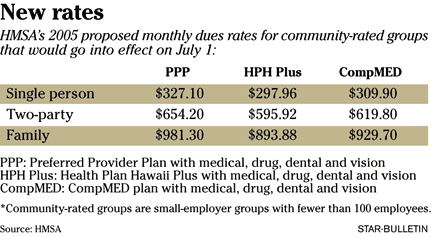HMSA requests
4.9% rate increase
The isle insurer cites
lower-than-expected
health costs in seeking
a relatively small hike
Hawaii Medical Service Association, under fire for its half-billion-dollar reserve level, is seeking a 4.9 percent average increase in insurance rates for its small-employer groups which would match the insurer's smallest hike in seven years.
![]()

In addition, HMSA said it has begun a $40 million computer operating system replacement project that will upgrade its claims processing and information management capabilities. HMSA said it will use health plan reserves to pay for the project's costs, and expects the upgrade to take three to four years.
HMSA Chief Financial Officer Steve Van Ribbink said the relatively small rate increase request and the investment-income rate subsidy are not related to bills before the state Legislature calling for HMSA to refund $100 per member out of the insurer's reserves. At the end of the third quarter, HMSA's reserve level was at $516.3 million, or the equivalent of 3.9 months in reserve if it operated for that long without receiving any dues. The reserve level grew in the fourth quarter because of the jump in the stock market during November and December, Van Ribbink said.
"The reason why the rate (request) is as low as it is is because we've now had two calendar years where the national trend of health care costs did not materialize as high as we feared it might," Van Ribbink said. "We do believe that part of the reason for that is due to the effectiveness of our disease management programs, some of which have been in place now for four to five years."
For example, Van Ribbink said the quality of life has improved for diabetes patients while HMSA's corresponding costs have declined.
HMSA's small-employer groups represent more than 11,000 businesses in the state with fewer than 100 employees. Overall, the covered members comprise about 141,000 of HMSA's 690,000 members.
The 4.9 percent rate increase request covers prescription drug, dental and vision and includes the HMSA Preferred Provider Plan, which is the most popular plan among HMSA's members, and the CompMed plan. The Preferred Provider Plan's members pay 10 percent of all benefits, while under the CompMed, which began last July, members pay 20 percent.
The 4.9 percent rate increase marks the second straight year that HMSA has asked for a lower rate request than the previous year. HMSA raised rates 9.9 percent in 2003 and 7.8 percent in 2004. The last time that HMSA raised rates as little as 4.9 percent was in 1998.

All increases for the small- employer groups would take effect July 1, if approved.
Businesses with 100 or more employees renew their insurance at different times of the year and saw their premiums rise an average of 5 percent beginning last month.
Bette Tatum, state director for the National Federation of Independent Business, welcomed the smaller rate request.
"The small-business community would prefer no increase or a decrease, but at least the increase isn't as high as it has been in the past, which is a good thing for Hawaii's small, beleaguered businesses," said Tatum, whose organization has 4,000 members statewide.
Van Ribbink said the HMSA board decided to apply 100 percent of its investment income to the insurer's premiums because of HMSA's "good" financial performance in 2003 and 2004.
State Insurance Commissioner J.P. Schmidt said his agency has not had a chance to analyze HMSA's filing yet, but that he thought the low rate increase request and the increased subsidy from HMSA's investments was based on several factors, including a recognition that the insurer's reserves had grown too big, bills in the Legislature to lower the cap on reserves, rising investment returns and new competition from Summerlin Life & Health Insurance Co.
Van Ribbink, though, said he first began discussing with Schmidt in September the idea of a 100 percent investment income subsidy to reduce rates and that the conversation came before the legislation was introduced.
Schmidt acknowledged that he did talk with Van Ribbink before the Legislative session about HMSA's investment returns and reserves.
A Senate bill would lower a managed care plan's level of reserves to 30 percent of annual expenses from the current level of 50 percent. HMSA's reserve level at the end of the third quarter was about 33 percent.
"We feel that it's bad policy from the standpoint that where there had been problems with insurance companies in the past, it's been because of inadequate reserves, not because of the need to have a ceiling on reserves," Van Ribbink said. "We feel that the reserves we've maintained are prudent and adequate under the circumstances we face, particularly in this state, and we feel that the bill is unnecessary."
[News] [Business] [Features] [Sports] [Editorial] [Do It Electric!]
[Classified Ads] [Search] [Subscribe] [Info] [Letter to Editor]
[Feedback]
